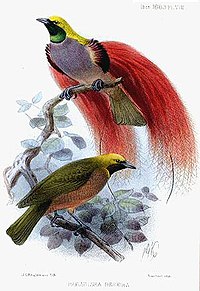
Photo from wikipedia
Sexual selection theory states that the premating (ornaments and armaments) sexual traits should trade off with the postmating (testes and ejaculates) sexual traits, assuming that growing and maintaining these traits… Click to show full abstract
Sexual selection theory states that the premating (ornaments and armaments) sexual traits should trade off with the postmating (testes and ejaculates) sexual traits, assuming that growing and maintaining these traits is expensive and that total reproductive investments are limited. Male-male competition and sperm competition are predicted to affect how males allocate their finite resources to these traits. Here, we studied relative expenditure on pre- and postmating sexual traits among 82 species for three mammalian orders with varying population density using comparative phylogenetic analysis. The results showed that population density affected sexual size dimorphism (SSD) in both Artiodactyla and Carnivora, but not in Primates. However, relative testis mass and sperm size were not affected by population density. Moreover, we did not find associations between the SSD and testis mass or sperm size in three taxonomic groups. The interspecific relationships between pre- and postcopulatory sexual traits did not change with increased population density. Our findings suggest that population density did not affect variation in the relationship between pre- and postcopulatory sexual traits for these three mammalian orders.
Journal Title: Animal Biology
Year Published: 2019
Link to full text (if available)
Share on Social Media: Sign Up to like & get
recommendations!